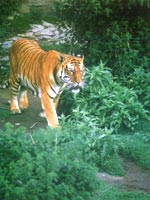Program : 3 Days Extension
Departures : Available as an extension to any trip to Nepal
Costs : Click here for price list
One of Asia’s top wildlife sanctuaries, Chitwan National Park was once a hunting reserve, but has been protected since 1973 so that visitors can observe and enjoy its splendid array of animals and birds. Bordering the northern plains of India, Chitwan’s 967km² of jungle-clad hills, plains and wetlands form part of the Terai, a region populated by the Tharu, one of Nepal’s few indigenous tribal groups, who appear to have a natural immunity to malaria.
The park is drained by two major rivers, the Narayani and the Rapti, whose wetlands provide a habitat for many birds. Some are resident and breed in the park, while others stop off to feed and rest during their autumn and spring migrations. The marshes give way to grassland and luxuriant forests of sal trees, flame of the forest, pipal, strangler fig and beautiful scarlet-flowered kusum trees, home to different types of birds and many mammal species. The wildlife of the park includes 46 mammal species, 400 bird species, 60 different butterflies and many reptiles. Among them are:
One-horned rhinoceros Gharial crocodile
Sambar, spotted, barking & hog deer Eagles
Gaur (bison) Kites
Jackal Osprey
Wild dog Hawks
Wild boar Storks
Royal Bengal tiger Cranes
Leopard Ibis
Civet Hornbills
Langur monkey Kingfishers
Rhesus monkey Orioles
Marsh mugger crocodile Flycatchers
Woodpeckers
Parakeets Warblers
The best time to visit Chitwan is from October to February, when temperatures average 25°C. March to May are hotter, and from April onwards thunderstorms can occur. Our two-night safari to Chitwan includes accommodation at a jungle lodge and a full programme of activities. During your stay you can experience a thrilling elephant back safari in search of the great one-horned rhino, jungle walks, canoe rides and a visit to a Tharu village. You may hope to see rhino, deer, monkeys and gharial and if you are very lucky, more elusive species including leopard and tiger. Bird watching can be rewarding at any time of year.
Note : Chitwan is a malarial area. Prophylaxis is advisable and you should cover up and use a good insect repellent containing DEET.
Outline Itinerary :
(This is an example of a typical programme – the actual itinerary may differ slightly depending on the time of year you visit, the weather and wildlife movements)
Day 1: A three hour journey by road to your lodge on the perimeter of Royal Chitwan National Park. After lunch, meet the elephants at the stables and take your first elephant back ride. The afternoon light can be very good for photography. Relax over a drink on the terrace, followed by dinner in the restaurant.
Day 2: Dawn wake-up call and a two-hour elephant back safari in the cool of the morning, when the birds and many mammals are at their most active. After breakfast at the lodge, we take to traditional dug-out canoes for a relaxing ride on the Rapti River and a chance to observe aquatic birds and see animals along the river banks. Visit the gharial crocodile conservation project and take a jungle walk with a tracker and ranger. Lunch back at the lodge and a siesta in the heat of the day. Watch the elephants being bathed in the river – you are welcome to join in! Then, visit a Tharu village and learn about these people, who with their resistance to malaria were once the only inhabitants of the Terai. Return to the lodge for dinner.
Day 3: Early morning wildlife viewing, followed by breakfast and then check out for the return journey to Kathmandu.


